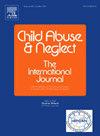Juvenile parricide in Turkey: Forensic psychiatric perspectives on child abuse, family violence, and fatal outcomes
IF 3.4
2区 心理学
Q1 FAMILY STUDIES
引用次数: 0
Abstract
Background
Juvenile parricide— defined as the killing of a parent by a child or adolescent —is a rare but devastating form of family violence, often rooted in chronic abuse, emotional dysregulation, and untreated psychiatric conditions. Despite its severity, systematic research remains limited, particularly in non-Western contexts.
Objective
This retrospective study examined the forensic psychiatric, sociodemographic, clinical, and offense-related characteristics of juvenile parricide offenders (JPOs) in Türkiye and identified factors associated with fatal outcomes, victim identity, weapon type, and offender gender and age.
Participants and setting
The sample consisted of 29 adolescents (aged 12–18 years) referred to a national forensic board in Türkiye for psychiatric evaluation following an act or attempt of parricide between 2017 and 2023.
Methods
A retrospective descriptive analysis was conducted using forensic psychiatric reports. Data included demographics, psychiatric history, substance use, abuse histories, weapon type, and offense characteristics. Descriptive statistics and group comparisons were performed using Fisher's Exact Test.
Results
Most offenders were male (75.9 %) with a mean age of 15.19 ± 1.39 years. Biological fathers were the most common victims (69 %). The most frequently used weapons were sharp objects (48.3 %) and firearms (41.4 %). Psychiatric disorders were present in 31 %, and 62.1 % had a history of abuse. Fatal outcomes were significantly associated with sharp object use (p = 0.014), absence of substance use (p = 0.013), and lower rates of prior offending (p = 0.033). Abuse history was more prevalent among those who killed their fathers than their mothers (p = 0.004). Weapon choice varied by age group: younger adolescents (12–14 years) primarily used firearms, while older adolescents (15–17 years) more often used sharp objects (p = 0.008).
Conclusions
Juvenile parricide offenders in Türkiye exhibit distinct developmental and trauma-related risk profiles. These findings underscore the importance of culturally informed, trauma-sensitive forensic evaluations and early intervention strategies—particularly in regions with high rates of family violence and limited access to child mental health services.
土耳其的青少年弑父:儿童虐待、家庭暴力和致命后果的法医精神病学观点
青少年弑父——被定义为儿童或青少年杀害父母——是一种罕见但毁灭性的家庭暴力形式,通常源于长期虐待、情绪失调和未治疗的精神疾病。尽管其严重性,系统的研究仍然有限,特别是在非西方背景下。目的本回顾性研究考察了日本未成年杀父犯(JPOs)的法医精神病学、社会人口学、临床和犯罪相关特征,并确定了与致命结果、受害者身份、武器类型、罪犯性别和年龄相关的因素。参与者和背景样本包括29名青少年(12-18岁),他们在2017年至2023年期间有过杀父行为或企图,被转介到土耳其的国家法医委员会进行精神病学评估。方法采用法医精神病学报告进行回顾性描述性分析。数据包括人口统计、精神病史、药物使用、滥用史、武器类型和犯罪特征。描述性统计和组间比较采用Fisher精确检验。结果男性居多(75.9%),平均年龄15.19±1.39岁。生父是最常见的受害者(69%)。最常使用的武器是利器(48.3%)和火器(41.4%)。31%的人有精神障碍,62.1%的人有虐待史。致命结果与使用尖锐物体(p = 0.014)、不使用物质(p = 0.013)和较低的先前犯罪率(p = 0.033)显著相关。虐待史在杀害父亲者中比杀害母亲者更为普遍(p = 0.004)。武器的选择因年龄组而异:年龄较小的青少年(12-14岁)主要使用火器,而年龄较大的青少年(15-17岁)更多地使用利器(p = 0.008)。结论我国青少年杀父犯表现出明显的发育和创伤相关风险特征。这些发现强调了了解文化、对创伤敏感的法医评估和早期干预战略的重要性,特别是在家庭暴力发生率高和获得儿童心理健康服务机会有限的地区。
本文章由计算机程序翻译,如有差异,请以英文原文为准。
求助全文
约1分钟内获得全文
求助全文
来源期刊

Child Abuse & Neglect
Multiple-
CiteScore
7.40
自引率
10.40%
发文量
397
期刊介绍:
Official Publication of the International Society for Prevention of Child Abuse and Neglect. Child Abuse & Neglect The International Journal, provides an international, multidisciplinary forum on all aspects of child abuse and neglect, with special emphasis on prevention and treatment; the scope extends further to all those aspects of life which either favor or hinder child development. While contributions will primarily be from the fields of psychology, psychiatry, social work, medicine, nursing, law enforcement, legislature, education, and anthropology, the Journal encourages the concerned lay individual and child-oriented advocate organizations to contribute.
 求助内容:
求助内容: 应助结果提醒方式:
应助结果提醒方式:


